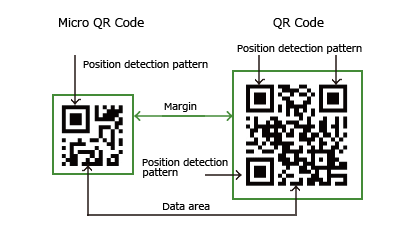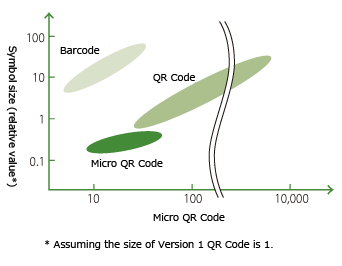Micro QR Code

A major feature of Micro QR Code is it has only one position detection pattern, compared with regular QR Code that require a certain amount of area because position detection patterns are located at the three corners of a symbol.
Furthermore, QR Code requires at least a four-module wide margin around a symbol, whereas a two-module wide margin is enough for Micro QR Code. This configuration of Micro QR Code allows printing in areas even smaller than QR Code.
データ容量とコードサイズ

The amount of data that can be stored in a Micro QR Code is not so large (max. 35 numerals).
Since this type can encode data more efficiently than the regular QR Code, its size does not have to be made much larger as the amount of data stored increases, unlike the case with the regular code (see figure on the right).
There are 4 variations, M1 to M4, of this type of code. The maximum amount of data that can be encoded for the maximum version of this code, M4, is smaller than that encoded by Version 1 of the QR Code.
Maximum Data Capacity Table for each Micro QR Code Symbol Version
level
(Reference: Data capacity of QR Code Ver. 1)
level
M
Q
H
34
27
17
20
16
10
14
11
7
8
7
4
Standardization of Micro QR Code
Micro QR Code is a public domain 2D code whose specifications are, as is the case with the QR Code, made publicly available, and whose patent rights in DENSO WAVE's possession are waived by the company.






